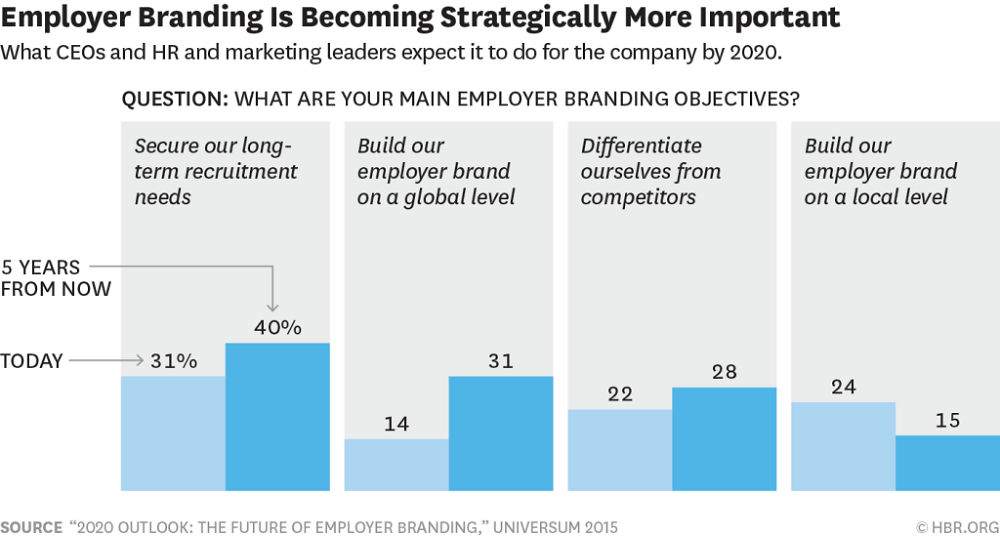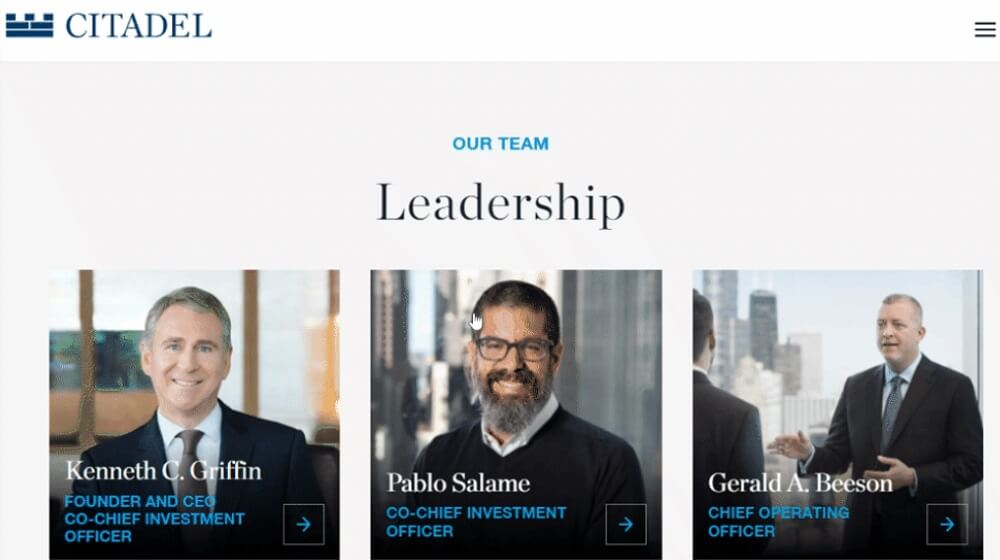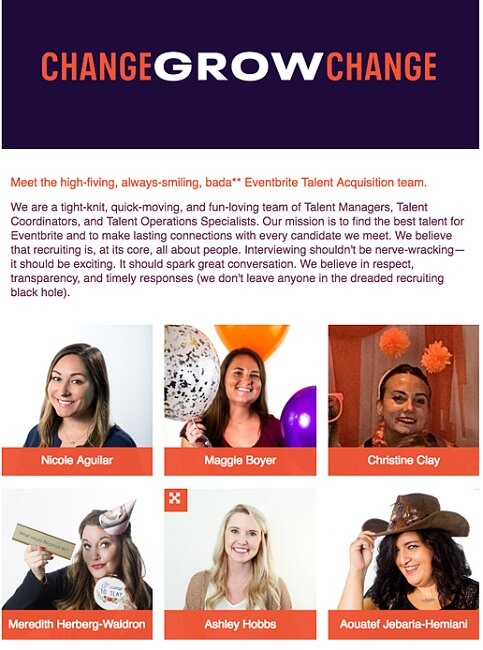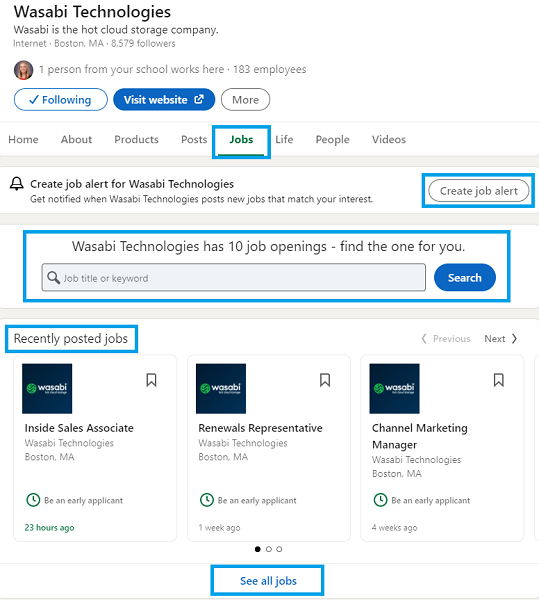When you’re hiring new staff for your company, remember that your ideal candidate is choosing you as much as you’re choosing them. That’s where employer branding comes in. Without a strong employer brand, qualified prospects will hesitate to submit their application and jumpstart the hiring process.

A solid employer brand strategy can save you from awkward interviews with the wrong type of candidates.
However, many growing businesses may not be hiring 24/7. Regardless of where you are in the hiring journey, employer branding matters as you’ll want to retain current talent as well. Below, we’ll discuss ways to market your employer brand and improve your employer branding strategy to attract, recruit, and retain the best potential candidates for your business. Some of our key points cover need-to-know employer branding information, like:
- What is employer branding?
- Why is employer branding important?
- Seven easy steps to create a winning employer branding strategy.
You’ll leave this post feeling like you have the tools to protect and project company values to current and prospective employees for a strong, stand-out brand.
What is employer branding?
Employer branding refers to your business’s reputation and makes prospective employees inclined to work with you.
Your employer branding strategy is the process of marketing your organization by providing an employee experience and work culture that attracts your ideal job candidates. It helps to position your business as a competitive employer. It also influences the perceptions of job seekers and employees.
Think of employer branding in relation to your business’s overall brand. Your brand has a target audience that you persuade to become customers. Whereas, your employer brand targets potential hires and current employees. It urges them to work, or stay, at your company.
The better you are at marketing your employer brand, the higher your chances of attracting and retaining top candidates within your market niche.
Of course, employer branding is more than just describing your work culture or values to potential candidates. It involves strategic marketing planning to attract the best candidates possible. With employer branding, you ensure candidates get a seamless experience before, during, and after the hiring process.

An example of a strong employer branding strategy.
Why is an employer branding strategy important?
86% of people use public ratings like Glassdoor or Trustpilot to know if companies are any good before applying—which means that your employer brand matters more than you think.
You’re not alone in this race for a stellar employer branding strategy. In fact, 40% of businesses invest in employer branding to improve their recruitment marketing needs for the long term, while about 28% are improving their employer brand to help their business stand out.

This shows that the talent acquisition market is fierce, and only those with a strong employer brand will survive.
Let’s take a look at other common reasons why employer branding is important.
1. You attract and retain the best talent
Employer branding helps you put your best foot forward. Let’s say you have attractive company core values and a challenging work environment. Those aspects of your employer branding will cause compatible candidates to gravitate towards your business. This concept applies whether you’re a local home services brand looking to grow, a busy multi-location franchise, a small restaurant constantly in the hiring hustle, or any company in between.
Not only will you attract the best candidates, but you’ll also keep the great employees you already have. Employer branding reduced employee churn by 28%. Plus, 79% of employees who highly trust their employer feel motivated to work. When you have a strong employer branding strategy it creates a “snowball effect” of retaining top talent that will look out for the wellbeing of your business.
This is important because you’ll save hiring costs in the long run which can allow you to reallocate funds towards other crucial areas, like your marketing budget.
2. It cuts down the cost of hiring
When it comes to hiring, every company has a reputation and perception. If it is positive, more candidates will come to you. In fact, they’ll actively search your “Careers” page for when you have an opening.
Your employer branding does the hard job of convincing candidates to apply and look forward to getting hired. On the flip side, if your employer brand has a negative perception about it, it becomes hard to attract top talents, let alone retain them.
A successful employer brand helps to cut down costs per hire by 50%.
Although some expenses such as recruiter-related expenses and pre-employment screening are pre-set, a strong brand can assist cut variable costs like marketing, advertising, and time spent screening.
Moreover, a strong employer brand improves employee experience which might lead them to refer suitable candidates for open positions in the company—hence, cutting costs.

3. It adds to your brand value
Your business has competitors you need to stand out from. Not just for a larger market share, but to attract and retain lifetime customers.
Reviews matter when it comes to catching the eye of quality customers. Many customers are drawn to positive brands and will likely choose to work with yours when there are very few bad reviews about it online. For instance, when customers are aware that you treat your employees well and have a pleasant work culture, they tend to associate your brand with better service too.
In fact, 81% of consumers said they only buy from a brand once they can “trust the brand to do what’s right.” Plus, 29% of people say how a company treats its employees is their number one deciding factor when becoming a loyal customer. When it comes to choosing a brand in the first place, 27% of consumers say how a business treats their employees is the primary quality they look at.
4. Helps you stand out
If employer brand is the story you tell potential hires, then your employer value proposition should be the star of the story.
A clear attractive employer value proposition (EVP) differentiates your company from the competition. It also helps to build a brand whose business goals and values are aligned with your employees. This ensures you have a self-motivated, productive workforce who love their work and become brand advocates.
Workplace productivity will push your brand to newer heights and consequently, stand out in your industry. This healthy brand community pays you a wide range of dividends such as elevating your company to top places to work in the industry.

How to create an employer branding strategy
Let’s explore how you can create and implement an employer branding strategy that supports your long-term recruitment marketing plan. That way, you can attract the best talents, minimize hiring costs, and mitigate employee turnover.
Usually, recruitment marketing and hiring departments are responsible for developing employer branding strategies. They also often work with local marketing and communications teams to ensure brand consistency within your employment content strategy.
That said, you don’t need a ton of resources to create an employer branding strategy that rocks. Here’s how you or your team, however large or small, can create an employer branding strategy for your business:
1. Audit your business’s brand perception
If you’ve ever cringed over a bad review left by a customer online, you’ll know how it instantly leaves a bad notion of that product in your mind. It’s even worse when there are no follow-ups from the product owners that clarify or rectify the issue.
A similar phenomenon happens when you have an ‘unchecked’ employer brand perception online. The outlook is rarely a pleasant one.
Your online perception is a part of your brand identity—you don’t want to let that flop. If your company’s brand represents its values, your employer brand reflects how you, as an employer, embody those values.
50% of candidates wouldn’t work for a company with a bad reputation, even with a salary increase. This means auditing your brand’s perception and assessing your business’s external reputation can save you from hiring headaches.
Start by responding to negative reviews, and even positive ones, on career review sites like Glassdoor and Trustpilot. Or, conduct social media surveys and internal questionnaires to know what people are saying. Alternatively, when your budget allows it, you can hire a marketing partner that monitors company reputation.
Use this research to focus on highlighting the positive aspects of your company’s culture to set yourself as a top place to work, at the same time, improving certain areas that are lacking.

2. Identify your key differentiators
After auditing your brand’s perception online, you want to highlight the aspects that make your employer brand unique across your marketing channels.
These key brand differentiators are critical to your brand’s personality and set you apart from other companies in your industry. Much like how certain differentiators make your brand more attractive to your target audience.
Now, this is more than just visual appearance (i.e business logo) or positive reviews. It delves into your company’s values, culture, and vision to create an advantage that appeals to employees.
For example, this brand below shows its differentiation advantage by showcasing inclusion and diversity, marketing different career paths, and putting diverse faces to their company’s image.

This unique employer brand marketing differentiates them from other firms. It also attracts a diverse, high-talent pool of potential employees looking to work in an inclusive environment.
If your auditing revealed some displeasure amongst employees about feeling unheard or neglected, here’s where you clear the air. Reiterate in your employer brand marketing that your company is forward-thinking, inclusive, and welcomes diversity.
However, if you want to “talk the talk” you’ll also need to “walk the walk.” Be sure to resolve issues with any employees feeling left out in an amicable way. Next, create action items to help validate your claim that you’re, indeed, what you say you are.
3. Create your employer value proposition (EVP)
You’ve set your standard. You’ve also checked to see what your employees and others in your industry are saying about your employer brand—that’s a great start!
Now, it’s time to market those key differentiators you established in the previous step, as your new employer value proposition.
An employer value proposition encompasses the rewards, benefits, and other commitments your business makes to attract and retain the best employees. Think of your EVP as the main reason why an employee chooses to work with you as opposed to your competitor. This makes sense since top talent will only leave a competitor to join your company when you offer more value.
EVPs also translate offerings as an all-inclusive package that sets your employer brand on a different pedestal than other places of work. Ideally, this goes beyond marketing a list of perks and benefits to potential employees, albeit a part of it.
An effective EVP is employee-centric. Here’s what to do before you craft your unique employer brand proposition:
- Find out your brand’s perception. Do this both internally and externally. Does this perception align with your business goals or vision? How can you improve it to reflect your company’s values and culture?
- Research the unique benefits employees are looking for. This will help attract the kind of employees you need in your company. You can get this input from current employees. These benefits could include access to career development courses, other commuter credits and facilities, and housing subsidies.
- Leverage the hard-to-quantify aspects of employee satisfaction. For example, challenging work, employee recognition, a rich company culture, and values that align with their goals.
- Incorporate current EVP into existing systems. As well as your total compensation packages. Ensure they’re well communicated consistently and effectively.
Use the above tips to hone in on your unique employer value proposition to help your job posting stand out.
For a wholesome employer branding strategy, you’ll also want your EVP reflected in your marketing. Here’s how one brand demonstrated their EVP through their content marketing language:

This employer’s brand language is warm and inviting to aspiring job seekers. It’s fun, respectful, and reflects their values as a team. You could do the same by leveraging SEO campaigns to help with the search visibility of your website’s career page.
Related: Is your website ready for increased traffic to your career page? Find out with our free, instant website grader.
4. Establish your key performance indicators
At the heart of every successful employer branding strategy is a set of marketing metrics to measure employer brand growth and identify areas for optimization. Key performance indicators (KPI) are defined metrics that analyze the performance of your employer branding strategy and clue you in on how to improve to get the highest possible marketing ROI.
Before establishing KPIs for your employer brand, you must first refer to a set of employer brand marketing goals you create. Then, do a before-after analysis to understand past performance and optimize based on insights.
To put this into practice, let’s use this handy employer branding strategy funnel to explain the metrics to consider when establishing your employer brand KPIs:

Starting from the top, we have:
Industry awareness and perception
To establish KPIs for this stage, you must leverage certain metrics that measure how your employer branding is driving awareness within the industry.
For starters, you can leverage data from external relevant channels that are popular within your industry such as career sites, employer review sites, and talent networks. This will help you understand rating trends, branded search impressions, community growth, and employee engagement.
You can also use social media to build your brand to publish and circulate positive perceptions about your brand.
Candidate experience
The middle of the funnel measures candidate experience in the recruitment pipeline. While this stage is sometimes hard-to-quantify, there are common metrics that can help. For example, candidate quality and the cost or source of hires can be easily identified through conversations with your team and consistent reporting.
For example, you might focus on the number of clicks on the job advertisement to tell you how many candidates were interested. Additionally, you could track the number of clicks on the application button, to identify how many of those interested candidates were motivated to start the application process.
If you’re having more people starting the application, but receiving a lower number of applications overall, then your candidates are canceling their applications halfway. Candidate cancellations and dropouts indicate a bad candidate experience or an unattractive application process.
You should improve your employer branding strategy by adjusting and shortening the application process at certain points where candidates are likely to drop out of the funnel.
Employee experience
The last step in establishing KPIs for your employer branding strategy is to look within and measure your employees’ experiences. Common indicators for this metric are:
- Employee referral rate
- Employee satisfaction scores
- Employee attrition
- Employer site ratings
Generally, you can measure internal employee satisfaction by simply asking them via internal communications—emails, surveys, questionnaires, or even open conversations.
Pro tip: Use an employee schedule template to improve employee efficiency and satisfaction by reducing labor costs.
5. Develop your employer branding strategy
After taking a look at your current employer branding perception and planning your EVP, it’s time to piece everything together with an employer branding strategy that puts your best foot forward.
To do this, gather your key differentiators, EVP, and feedback on brand perception, to create messaging that addresses possible apprehensions candidates have about you. If your employer brand audit reveals that employees see you as negligent, aloof, or unconcerned—you should correct that perception in your brand messaging by discussing how you care for your team.
It also doesn’t hurt to highlight that you offer health insurance, employee discounts, and other benefits.
All in all, ensure that your branding is coherent and consistent with your business’s overall message. Try using video marketing, photo slideshows, blog posts, and more to communicate your employer brand messaging across platforms.
6. Monitor your employer branding strategy performance regularly
Creating your employer branding strategy is only half the battle. To bring success home, you must consistently monitor the impact of these changes on your employer branding perception.
It’s crucial to regularly audit employer review sites and take note of recurring trends. This will help you gain insight into whether employees see your brand positively or negatively, and where you need to focus your attention.
7. Adapt your employer branding strategy based on feedback
What’s the point of monitoring your performance, if it doesn’t impact your employer branding strategy? Since you can see what’s working and what’s not, you can adapt your strategy based on feedback.
For example, if a good number of potential hires are browsing through your Linkedin company page rather than on your business’s website, that’s an indicator that you should put more effort into directing candidates to learn more about you directly on your website. It also means you should pump more resources into optimizing your Linkedin company page to cover more than the basic information about your employer brand.

An example of using LinkedIn to draw in candidates as part of your employer branding strategy.
Conversely, you should communicate with existing employees internally to identify and resolve their own concerns. These unsolved concerns are what reflect on online spaces that plummet your employer brand reputation. You can get reliable information through employee surveys or questionnaires, anonymous suggestion boxes, and even department meetings.
Lastly, don’t marry your current employment branding strategy. Be nimble and ready to change your employer branding strategy accordingly as you come across all the KPIs mentioned above.
Showcase your employer branding strategy for heightened success
Creating and implementing a strong employer branding strategy is a fantastic approach to raising your company’s profile. Over time, you’ll gain a positive reputation as a sought-after company where people actively want to work. Your employees will turn into your cheerleaders as they become enthusiastic brand ambassadors.
Although your employer branding strategy might not produce immediate benefits, there is no quick way to improve your employer brand. The hardest part of employer branding is patience! Measuring and evaluating your employer brand strategy is the best way to determine its effectiveness and scalability in the long run.
Get tangible results through a constant cycle of experimenting and listening. When you pay attention to candidate and employee feedback, you’re setting yourself up for success through an elevated employer brand strategy.
To recap, here are the seven steps to create an employer branding strategy:
1. Audit your business’s current brand perception
2. Identify your key differentiators
3. Create an employer value proposition (EVP)
4. Establish your key performance indicators
5. Develop your employer branding strategy
6. Monitor your employer branding strategy performance regularly
7. Adapt your employer branding strategy based on feedback
About the author
Owen Jones is the Senior Content Marketer at ZoomShift, an online schedule maker app. He is an experienced SaaS marketer specializing in content marketing, conversion rate optimization (CRO), and Facebook advertising. He likes to share his knowledge with others to help them increase results.






